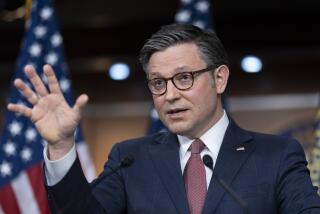Japan Moves to Step Up Spending, Boost Imports
TOKYO — Signaling an end to six years of belt-tightening budgets, Japanese Prime Minister Yasuhiro Nakasone and leaders of his Cabinet and the ruling Liberal Democratic Party decided Tuesday to adopt a “drastic and large-scale” supplementary budget that could increase imports.
Masayoshi Ito, chairman of the party’s policy board, said he expects the supplementary budget later this year to increase government spending by more than 5 trillion yen ($34.2 billion).
The decision to adopt a supplementary budget represents a dramatic turnabout. Although Nakasone’s government last fall approved a similar 3.6-trillion-yen ($24.7-billion) supplementary budget described as a pump-priming package, it failed to appropriate any more funds and actually reduced its spending while urging private industry to increase investment.
Tuesday’s announcement is expected to please U.S. officials who have been pushing Japan to boost its imports. The increased spending should accomplish that by expanding domestic demand.
The announcement was timed to coincide with Finance Minister Kiichi Miyazawa’s arrival in Washington. Miyazawa is expected to inform U.S. Treasury Secretary James A. Baker III and the finance chiefs of five other leading industrialized nations of Japan’s new commitment.
The new policy scraps the stringent budget restraints that have been a hallmark of Nakasone’s administration and that of his predecessor, Zenko Suzuki, dating back to 1980.
The government took immediate action Tuesday by calling in top executives of 151 Japanese corporations and urging them to increase their purchases of manufactured imports by at least 20%, or about $6.9 billion, in fiscal 1987.
Hajime Tamura, minister of international trade and industry, ordered the executives to submit by April 20 plans for increased imports and warned that firms that fail to list planned purchases adding up to a 20% increase will be subjected to special “guidance.”
The firms, which include manufacturers with a heavy reliance on exports, trading houses and department stores, had submitted plans to increase import purchases by only 8%.
The government forecast that its fiscal program would increase real growth to 4% in fiscal 1986, which ended March 31, but it left the domestic economy stagnant. Real growth in 1986 amounted to only 2.5%, the lowest level in 12 years.
Tuesday’s decision commits the government to a dramatic increase in spending. Ito’s pledge of an extra $34.2 billion would add 9.2% to government spending in the fiscal year that began April 1, compared to virtually no increase at all in the present budget.
The additional spending, if it proves to be as much as Ito said, would be the equivalent of 1.5% of last year’s gross national product of 330.8 trillion yen ($2.3 trillion).
Shintaro Abe, chairman of the Liberal Democratic Party’s General Affairs Council, is expected to offer more details of the new program when he visits Washington on April 19 as Nakasone’s special envoy. Abe, a former foreign minister, told U.S. Ambassador Mike Mansfield on Tuesday that he will try to find solutions to a series of American complaints against Japan before he leaves.
Abe will spend three days in Washington and then meet American business leaders in New York before returning to Tokyo on April 25, four days before Nakasone is scheduled to leave on a trip to the United States.
2 Other Programs Planned
A Foreign Ministry official said that two other major programs, one aimed specifically at reducing Japan’s trade surpluses and the other designed to spell out what “contributions to the international community” Japan is ready to make, are to be worked out before Abe leaves for Washington.
A written statement approved Tuesday by the party-Cabinet group said that government spending will be increased in part because of “an urgent need for Japan . . . to rectify its external imbalances, particularly the imbalance with the United States.”
Rising unemployment, economic stagnancy and “serious difficulties stemming from the yen’s sharp appreciation” were cited as other reasons.
On the Tokyo foreign exchange market, the dollar fell Tuesday to another record low, 145.25 yen, down 0.75 yen from Monday’s closing.
The Bank of Japan was reported to have purchased an estimated $500 million in an effort to shore up the dollar. It was the 11th straight day of such intervention, reportedly involving a total of $10 billion.
In their statement, the Liberal Democratic Party leaders and key Cabinet ministers did not spell out an exact figure for increased government spending. A high government official who asked not to be further identified said this was because the fiscal 1987 budget has not yet been approved by the Parliament.
Opposition to Tax
Announcement of a specific supplementary budget before the primary budget is adopted, the official said, would lead opposition parties to demand that the budget be rewritten. Debate on the budget has already been snarled for more than two months by opposition attempts to block Nakasone’s plan to impose a 5% value-added sales tax.
Ito told reporters that work on the supplementary budget will begin simultaneously with the beginning of work on next year’s budget, in late July or August.
The high government official, who called in foreign correspondents to explain the new policy, refused to say when the supplementary budget might be adopted, but it does not seem likely before September. A time-consuming revision of at least one law will be needed to provide some of the funds for it.
The statement supported Nakasone’s policy of eliminating by fiscal 1990 “deficit financing” bonds used to pay for operating expenses, but it made no mention of restrictions on issuing new “construction” bonds for investment in infrastructure projects. At present, Japan has $1 trillion in government bonds outstanding, $447.5 billion of them categorized as “deficit financing.”
More to Read
Inside the business of entertainment
The Wide Shot brings you news, analysis and insights on everything from streaming wars to production — and what it all means for the future.
You may occasionally receive promotional content from the Los Angeles Times.









